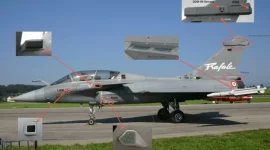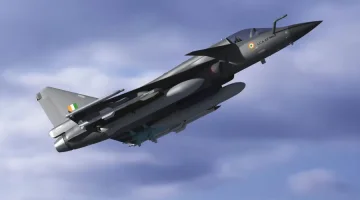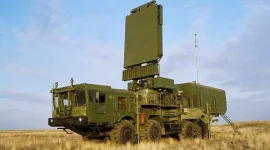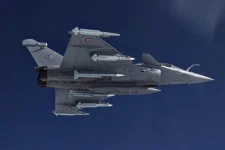The international market for fighter jets is experiencing a surge in demand as nations seek capable but affordable 4.5-generation aircraft.
In this competitive landscape, India's developmental HAL Tejas Mk2 is being positioned as a direct challenger to Sweden's Saab Gripen E, a long-established leader in the light combat segment.
With the Tejas Mk2 prototype scheduled for rollout by the end of 2025 and a first flight planned for 2026, the stage is set for a significant commercial battle.
The central question is whether India's indigenous fighter can compete with the Gripen E, which has already secured export success in countries like Brazil and has just been selected by Colombia.
Success for the Tejas would represent a multi-billion dollar breakthrough for India's Atmanirbhar Bharat defence policy.
The Incumbent vs. The Challenger
The Saab Gripen E has long been the "smart buy" for air forces operating on a budget, valued for its NATO interoperability and rapid turnaround times. Its position was further solidified in October 2025 with the first official delivery of a production aircraft to the Swedish Air Force.However, the Tejas Mk2, which will be powered by the same highly-regarded General Electric F414 engine, presents a compelling alternative. It aims to leverage a competitive price point, greater payload capacity, and options for customization to attract buyers, particularly in Asia, Africa, and Latin America.
Both aircraft are single-engine, delta-wing fighters designed for agility and low operational costs. They are both capable of "supercruise" (supersonic flight without afterburners) and possess a combat radius of over 1,000 kilometers.
A Tale of the Tape: Specifications
While they share a similar design philosophy, the Tejas Mk2 and Gripen E differ in key performance metrics that will influence potential buyers.- Payload and Weight: The Indian-made Tejas Mk2 is the heavier aircraft, with a maximum takeoff weight (MTOW) of 17.5 tons compared to the Gripen E's 16.5 tons. This allows the Tejas to carry a larger weapons payload of 6.5 tons across 13 hardpoints, slightly edging out the Gripen's 6-ton capacity on 10 hardpoints.
- Armament: This extra capacity allows the Tejas Mk2 to be marketed with heavier standoff weapons, including the future BrahMos-NG supersonic cruise missile and the indigenous Astra air-to-air missile. The Gripen E's arsenal is built around proven NATO-compatible weapons like the advanced Meteor missile.
- Range: The Tejas Mk2 features significant internal fuel capacity and can be fitted with large external drop tanks, giving it a ferry range of 3,500 km, which closes the endurance gap with the Gripen.
Avionics: Proven Maturity vs. Indigenous Tech
The primary difference lies in their electronic systems. The Gripen E benefits from years of development, featuring the combat-proven Raven ES-05 AESA radar and an advanced infrared search-and-track (IRST) system. Its open-architecture design allows for easy upgrades and famously short turnaround times of 10-20 minutes between missions.The Tejas Mk2 counters with a suite of cutting-edge, locally-developed systems. This includes the indigenous Uttam AESA radar, which utilizes advanced GaN (Gallium Nitride) technology, an AI-integrated electronic warfare package, and a modern, wide-area panoramic cockpit display.
While the Tejas may boast superior maneuverability (rated for 9g turns) due to its airframe, the Gripen's proven reliability in major international exercises like Red Flag gives it a psychological edge for cautious buyers.
The Deciding Factor: Cost and Geopolitics
The Tejas Mk2's most significant advantage is its price. Estimates place the Tejas Mk2's unit cost between $70-75 million, substantially lower than the Gripen E's price tag of $80-90 million.Furthermore, the projected lifecycle costs heavily favor the Indian jet. The Tejas is estimated to cost around $3,500 per flight hour, whereas the Gripen E's operational cost is estimated between $4,000 and $5,000 per hour. For nations looking to purchase and operate entire fleets, this long-term savings could be the deciding factor.
On the geopolitical front, the Gripen E has a commanding lead. Saab has secured numerous orders, and in April 2025, Colombia announced it had selected the Gripen. More recently, in October 2025, Sweden and Ukraine signed a Letter of Intent that could lead to a major acquisition of 100-150 Gripen fighters.
The Tejas Mk2, by contrast, is still in development. Its primary challenge will be overcoming "vaporware" perceptions, as its induction into the Indian Air Force (IAF) is not expected until 2029.
However, it has a key geopolitical advantage: it is offered as a "China-alternative" for nations wary of Chinese or Russian hardware.
Interest in the current Tejas Mk1A from countries like the Philippines, Argentina, Nigeria, and Egypt provides a strong foundation for HAL to begin its sales pitch for the more advanced Mk2.
Charting the Export Path: India's Roadmap to Global Sales
To succeed where the earlier Tejas Mk1 failed in the export market, India must execute a clear strategy:- Solve the Engine Bottleneck: The GE F414 engine is subject to U.S. export controls. The immediate solution is the landmark deal for GE to co-produce the F414 engine in India. The long-term strategic goal is to fully fund and complete the indigenous GTRE Kaveri 2.0 engine, which would allow for unrestricted exports.
- Scale Production: A large domestic order is essential. The Indian government's clearance of a deal for 97 additional Tejas Mk1As in September 2025 will help scale up production lines. Partnering with private Indian firms like Tata and Adani will be crucial for fulfilling offset obligations and offering local manufacturing to buyers, similar to how Brazil co-produces the Gripen.
- Aggressive Marketing: India must accelerate flight testing in 2026 with export-focused configurations, including the integration of NATO-standard weapons like the Meteor missile. Offering attractive Lines of Credit and ensuring high-level diplomatic support will be key.
- Lifecycle Support: India must match Saab's reputation for excellent 30-year sustainment packages by offering dedicated Maintenance, Repair, and Overhaul (MRO) hubs in customer nations to guarantee low downtime.
With a strategic focus on indigenous technology and smart marketing, the Tejas Mk2 could realistically challenge the Gripen E and secure a significant share of the global fighter market by 2035.





